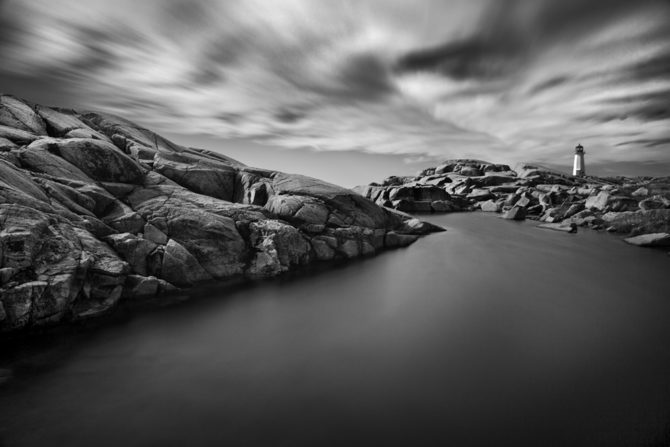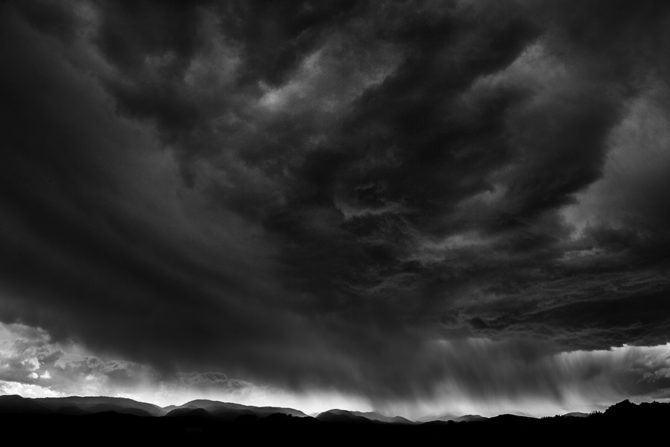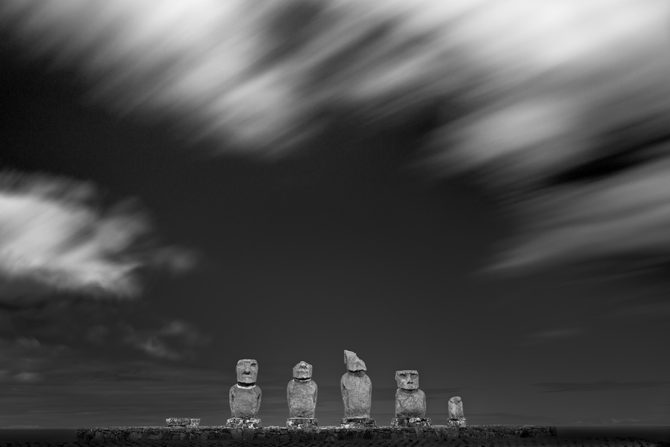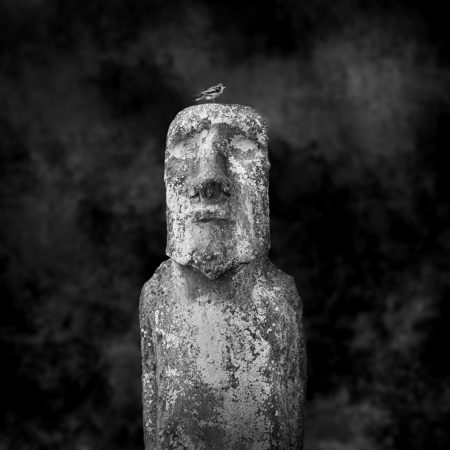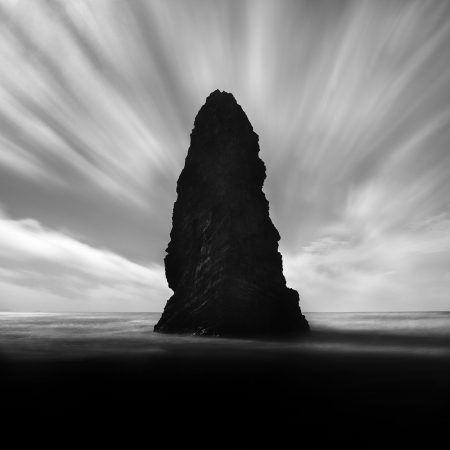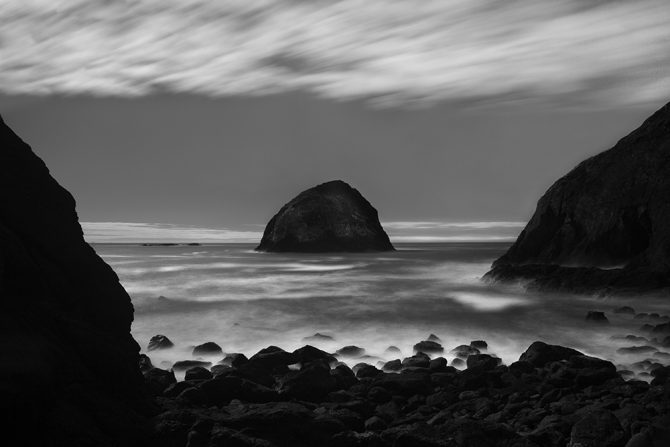Category: Vision
November 6, 2015
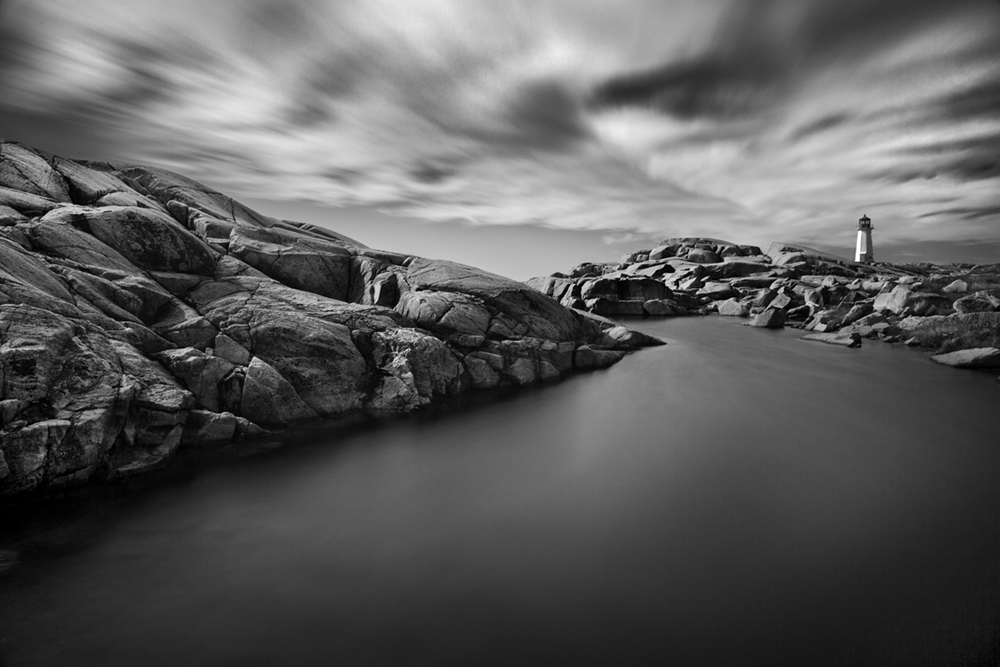
Peggy’s Cove, Nova Scotia
I’ve just driven 7000 miles in 22 days and during that time traveled through 22 states and 2 Canadian Provinces. That’s a lot of time in the car and it afforded a lot of thinking.
And what I’ve been thinking about is Passion and how it relates to Vision.
I noticed that as I drove through the incredibly beautiful autumn scenery of New England, I was not inspired to create. But when I came across water of any kind, and particularly along the coast, I found myself excited and creating.
Now one might initially attribute this to me being a black and white photographer in the middle of a color wonderland. But I don’t think that’s what it was. Fall colors can make for some amazing black and white images and I know that there are great images in those hills.
And yet here were thousands of photographers flocking to the area to shoot the beauty of the mountains and trees…and I’m only taking the occasional iPhone snapshot to send back to my family! Why?
My conclusion is that I just don’t feel a Passion for mountains and trees, but I do for water.
But “why” do certain environs inspire me while others do not? I don’t know and the “why” is not very important to me: what’s important is that I recognize the source of my Passion and then do something about it.
In the past I’ve tried to force projects that I didn’t have a Passion for: the projects languished, I had to force myself to work on them and I was not happy with the results. Not one of those projects were ever successful.
Never. Not one. Ever.
And so I’ve decided that with my limited time I will only focus on the places and things that excite me most, and for now that’s water and the coast.
I’ve long understood the role of Vision in creating work that I love, but now I’m beginning to appreciate the role of Passion as being nearly as important.
With Vision I can create unique images. With Passion comes an excitement that drives me.
And while I might use each one individually to some success, I now realize that my best work is created at the intersection of Vision and Passion.
Cole
May 28, 2015
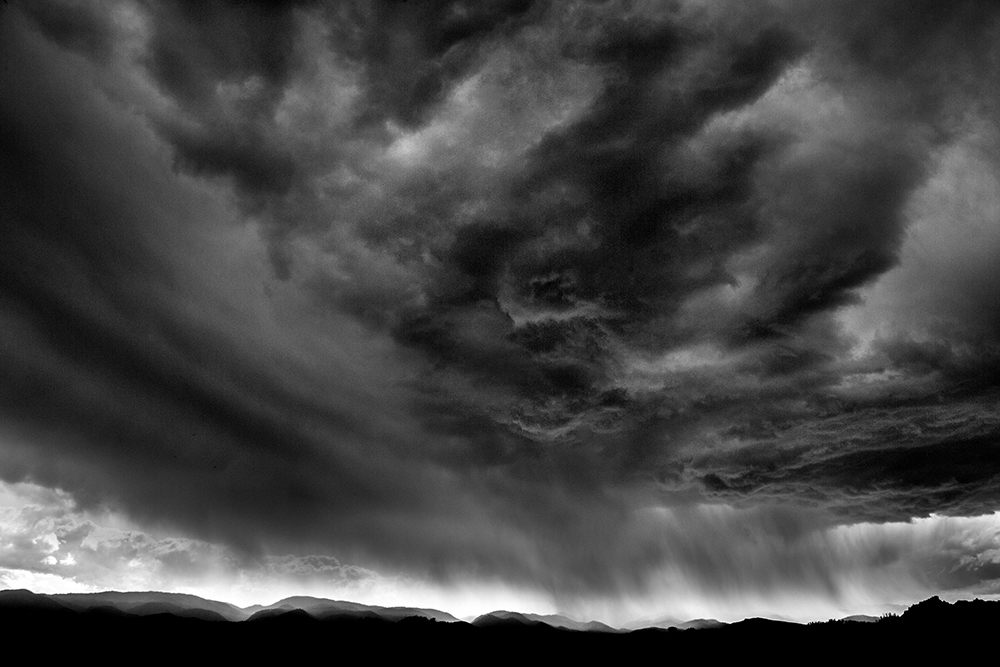
Storm Cloud, 2015
.
I have been accused of being arrogant for suggesting that the source of my Vision lies within myself and is not dependent upon the outside world or those who have gone before me.
I don’t believe this to be an arrogant idea. But here are some additional thoughts that may convince the unconvinced that I am in fact, arrogant.
.
Look inward.
Everything you need is already there.
Discover your Vision.
See for yourself.
.
We are all creative as children.
But then we learn how to seek approval.
And something atrophies and almost dies.
We forget how to please ourselves.
.
There is a difference between Vision and Inspiration.
Inspiration comes from without, Vision comes from within.
A person can only do so much with Inspiration.
Inspiration without Vision is an unproductive effort.
.
Look inward.
Ignore what others are doing.
Do what you feel inspired to do.
Create work that you love.
.
Art is very selfish.
Or at least it should be.
If you are creating for others,
then you are not creating your best work.
.
Do not compare your work to other’s.
Judge your art only by how you feel about it.
Create art that you are proud of.
Create art that you love.
.
Look inward.
You harbor that secret ingredient.
The secret to success.
Your Vision.
.
.
May 8, 2015
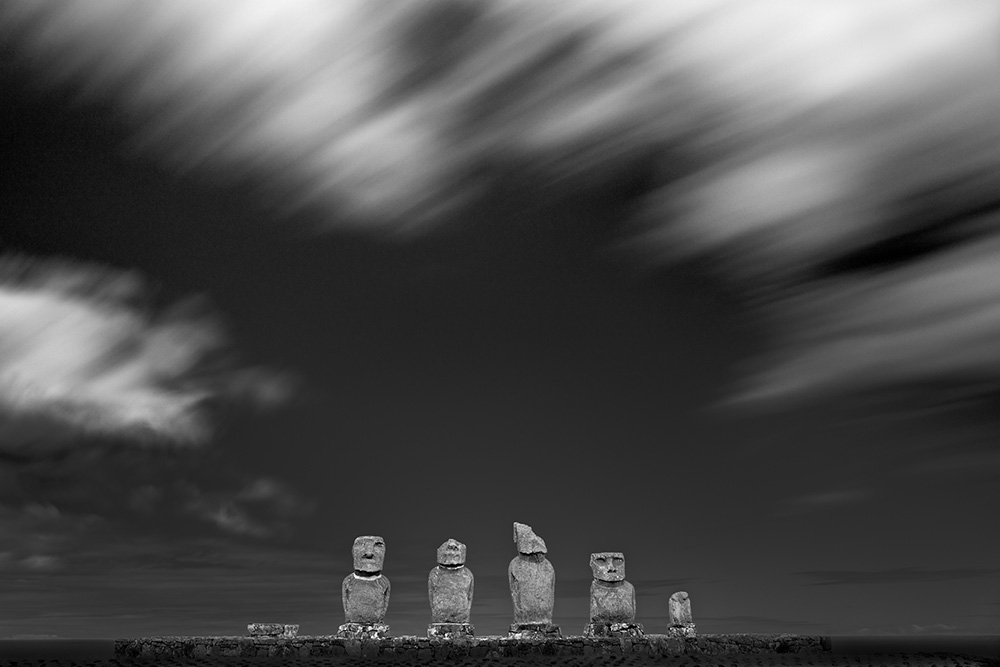
When I photograph, I do not seek to create images that are “different” from everyone else’s, I don’t calculate how to create unique images and I don’t research what others are doing and then react.
Different is not my goal.
Instead, my objective is to produce work that comes from my Vision and that is honest and original to me.

My work is all that I focus on and have control over. As my mother used to say: what others are doing is none of your business!
When I went to Easter Island the only photographs that I had ever seen were the 1950’s documentary images contained in Thor Heyerdahl’s book “Aku Aku.” I never looked at anyone else’s images for two reasons; first I didn’t want to subconsciously copy someone else and secondly I didn’t want to consciously try to be different from someone else.
My goal, as much as it was humanly possible, was to work in a creative vacuum. I wanted to see the Moai through my Vision and find my own Passion.
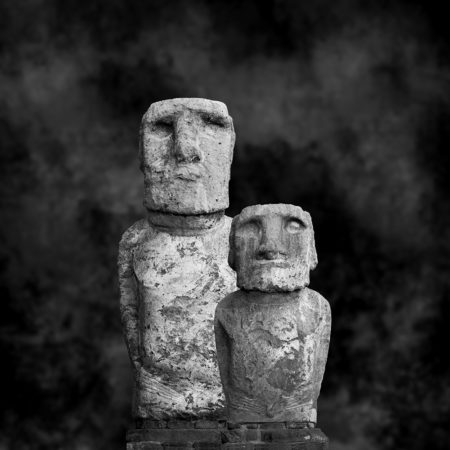
Are my Easter Island images unique? I may never know the answer to that as long as I practice Photographic Celibacy and do not look at other photographer’s work.
And to tell you the truth, I don’t want to know. I love my images and am content with the knowledge that they were created honestly through my Vision.
Cole
April 24, 2015
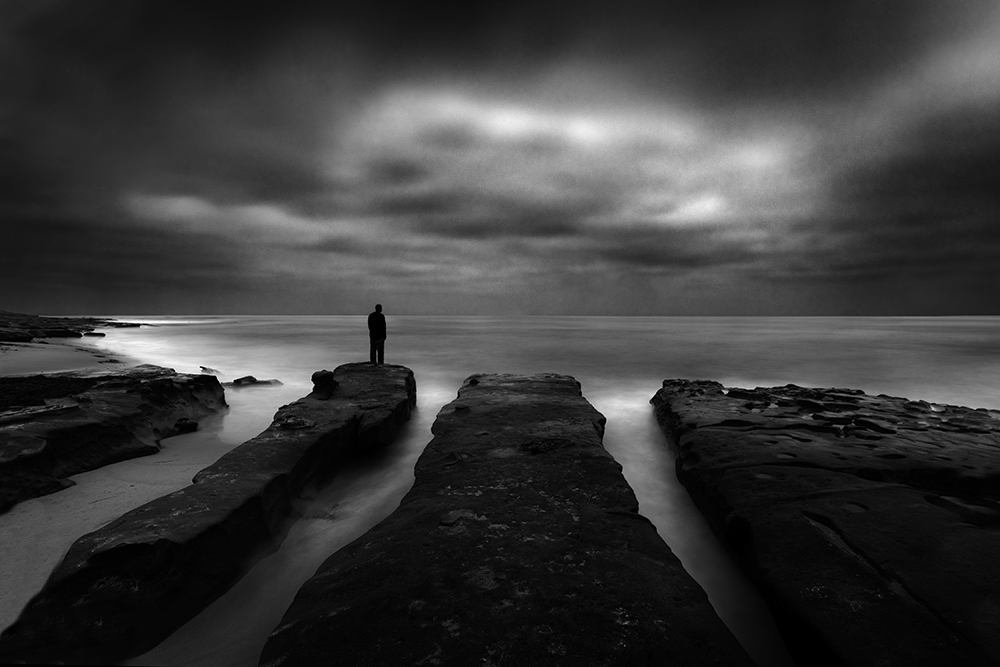
Last week someone asked if I was flattered when people copied my work. I said no, but that I wasn’t offended either.
What I actually feel is a bit of sadness. I’d rather see that person putting their energies into finding and following their Vision rather than walking where I have already walked.
Now these are friends and well-wishers who send me these imitations and so I am sincerely touched by the kind gesture. Sometimes they send a Lone Man or a Harbinger and sometimes it’s an Old Car Interior.
But honestly, I’d prefer they sent me something that they had created from their own Vision.
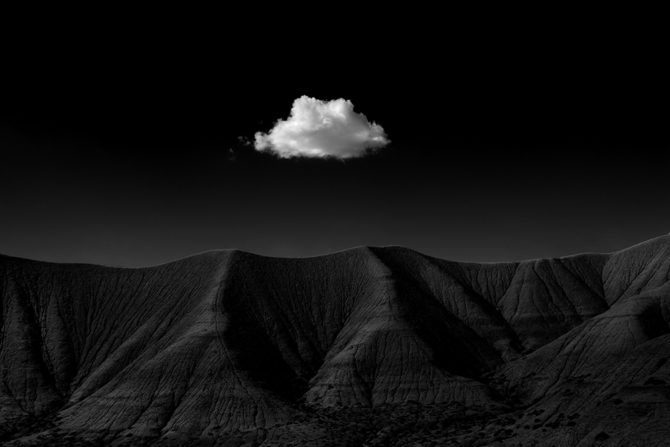
I very well understand imitation because I’ve copied other artists too, sometimes unconsciously and unfortunately sometimes consciously. For years I tried to copy Ansel’s work, and not just his look. Once I went to Yosemite and tried to recreate specific images of his!
I look back now and see how silly that was. Was my goal in life to be known as the world’s best Ansel Adams copycat?
Someone once wisely said to me: “Ansel’s already done Ansel and you’re not going to do him any better.” It’s true.
I know that many believe that imitation is a part of the learning process. I have many photography students contact me to say that their assignment is to copy one of my images.
I must say that I strongly disagree with this approach. I believe that their time would be much better spent finding their own Vision, and that imitation actually retards their personal Vision progress.
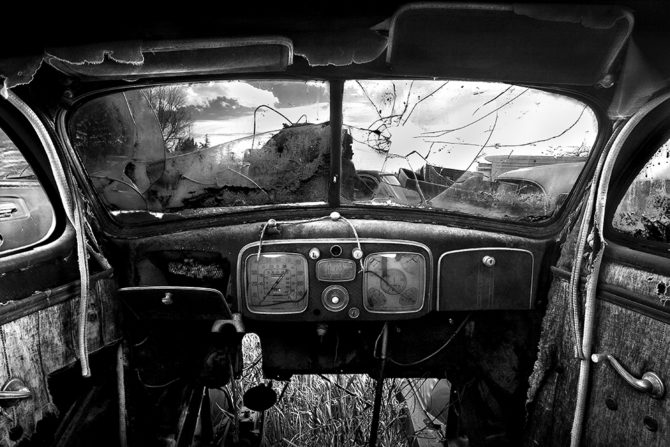
Colefucius says: They who walk in another’s footsteps, never finds their own path.
Is imitation is the sincerest form of flattery? I don’t think so.
Cole
March 20, 2015
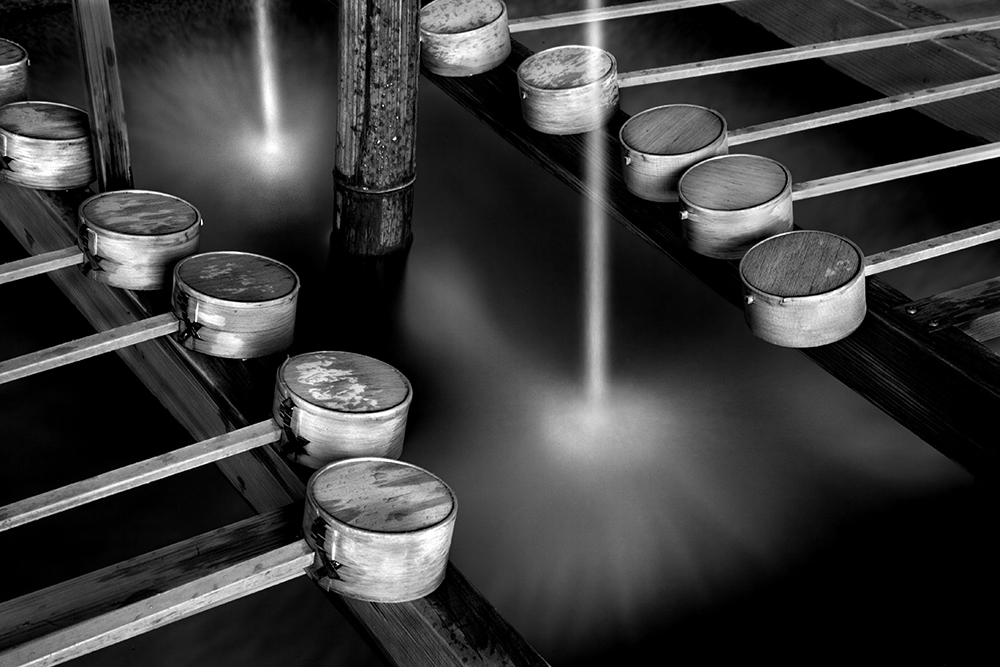
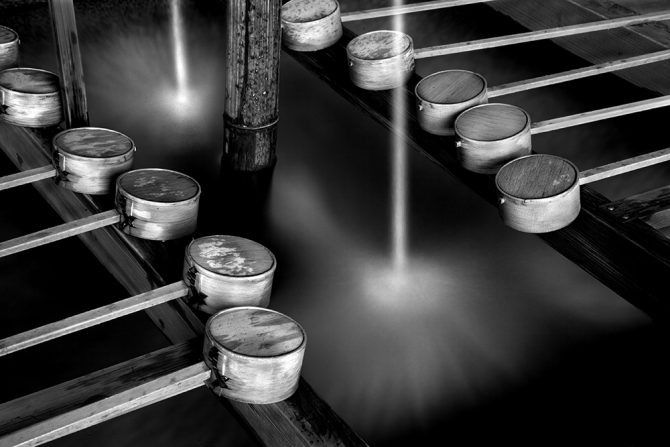
People write to me about their projects and say such things as:
I just cannot get motivated…
I’m in a slump…
My project is on hold…
I haven’t shot anything in a while…
I don’t know what’s wrong…
I need to get back to it…
I just can’t seem to finish it…
My rule of thumb is: If I am not energized and excited about my project, then it’s time for me to:
CHOOSE A NEW PROJECT
For me, a successful project must have two ingredients: Vision and Passion. If I don’t feel these I know the project is doomed, it will be a chore to work on and that lack of passion will be felt by the viewer.
Many feel that the key to a successful project is to have a unique subject, an exotic location or an interesting technique. And while those qualities may help, only Vision and Passion can ensure success.
When you have the right project, you cannot wait to get home to work on it. The right project has you getting up early and skipping meals. When you have the right project you find yourself working long hours and wishing there were more.
And most importantly; when you have a Vision and Passion for your project, that energy and conviction will be felt through your images.
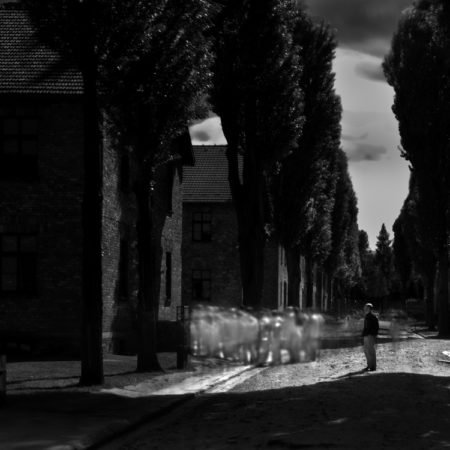
After I created the Auschwitz images many people suggested I apply the ghost theme to other locations. The idea sounded logical: the Auschwitz series had been well received and so why not leverage that popularity by using the same approach at other locations?
So I started to work on “The Ghosts of Great Britain” where I created ghosts at English castles. But the project fell flat because the images were not compelling and it all felt gimmicky.
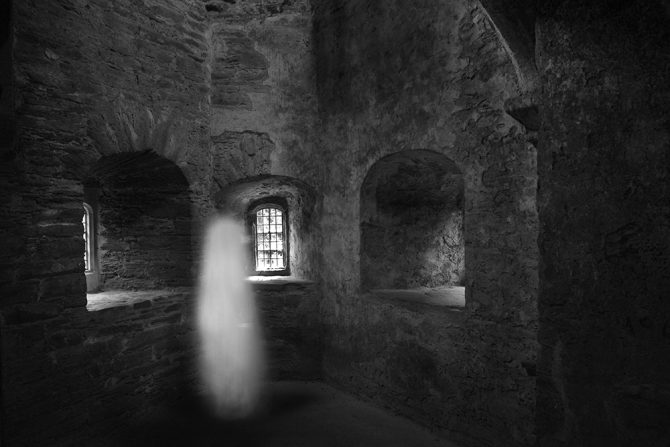
So what went wrong? The project lacked Passion.
At Auschwitz I felt inspired to create those images and I had a Vision for the project. I gave no thought as to how the series would be received and in fact I didn’t care!
But “The Ghosts of Great Britain” was completely contrived and calculated to be popular. I did not feel that same Vision or Passion for the project and it failed. I scrapped the series and only kept the one image above.
This was a great lesson for me and a mistake that I will never make again.
Many people ask where I get my ideas from and I tell them that every time that I have an idea, I write it down. And then I reveal that I’ve never once used any of those ideas! Every successful project that I’ve pursued has come to me spontaneously, unexpectedly and as a sudden burst of inspiration.
And then they ask: But what happens if you don’t have a project that excites and inspires you?
And I reply: Then I wait until I do.
Cole
P.S. I’ve mentioned “successful project” a few times now and I want to explain what I mean by that. I do not consider a project successful because it wins awards, is published, is exhibited or sells.
Success for me is creating a series that I love and am proud of, and that is the only kind of success that matters.
March 6, 2015
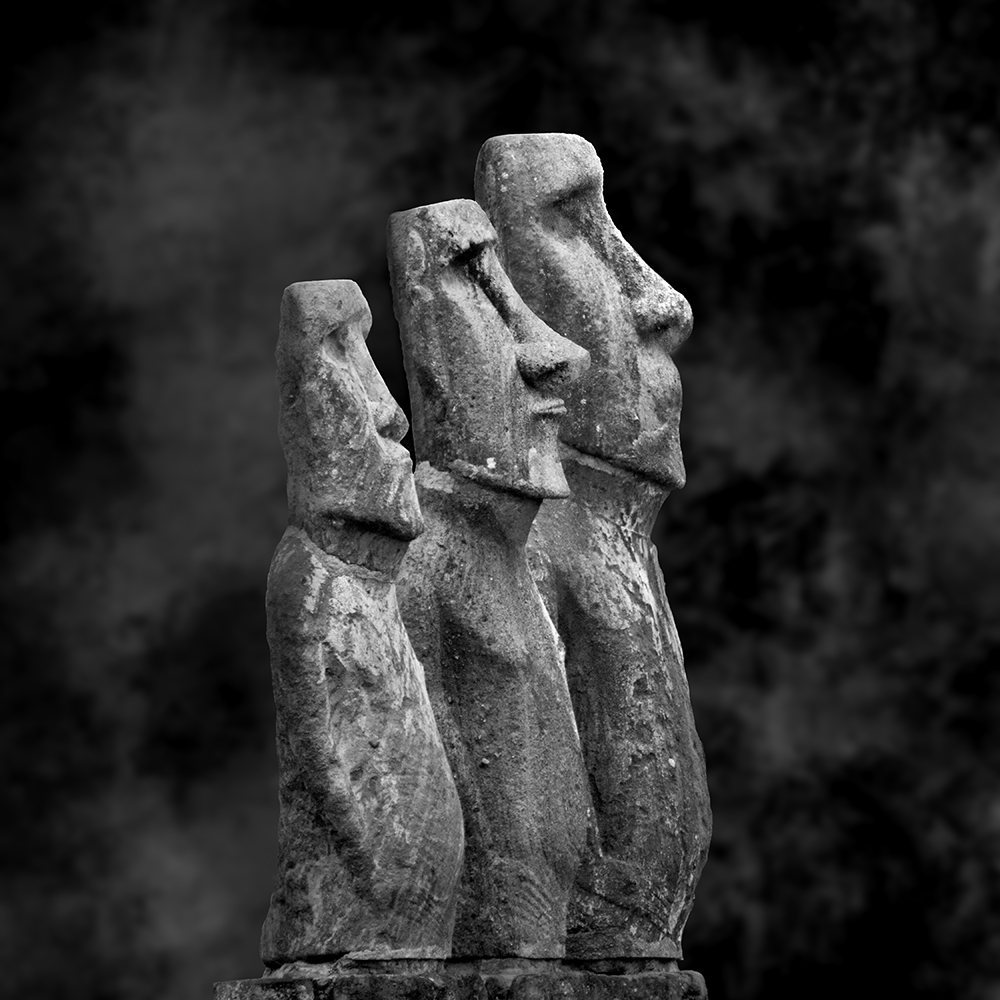
In January of 2015 I spent two weeks photographing the Moai of Easter Island. This fulfilled a lifelong dream, one that started when I was 17 and read the book “Aku Aku” by Thor Heyerdahl. I became fascinated with the Moai and they have been on my mind and influenced my art for these many years.
As I traveled to Easter Island and tried to imagine what I would encounter, something interesting happened: I dreamt that I had invited the Moai to come and sit for a formal portrait.
When I awoke I thought “why not?”
I knew there would be challenges: the Moai are reserved, aloof and almost unapproachable. They had suffered greatly at the hands of outsiders and the question was: would they come to trust me?
Distance was the first hurdle to be overcome: the island is small by automobile standards, but when we are talking about the Moai who walk everywhere, traversing the island to get to my makeshift studio could be difficult. Then there was the Moai’s physical condition: many were incapacitated by war and the ravages of time and could not make the journey. And how would I accommodate the size of the Moai, with some towering 33 feet tall?
Facing these challenges and armed with nothing more than a dream and hope, I issued the invitations…but would they come?
Initially only a few came; the younger and less suspicious ones. But slowly, as word spread of their experience, others started to arrive.
Photographing the Moai created some interesting situations: one older Moai refused to allow me to photograph his face and turned his back on the camera. Another arrived with a hawk and insisted on having his portrait taken with the bird atop his head. Several Moai with bullet holes inflicted by outsiders insisted that I document those scars.
And there were tense moments, as two rival Moai came together face-to-face in the studio, but which ended well when they agreed to be photographed together. And there were touching moments as old friends were reunited after years of separation.
The Moai are quiet, stoic and could even been described as “stone-faced.” And it’s true, not once was I able to photograph a Moai smiling, but instead they have a dignified poise that transcends time.
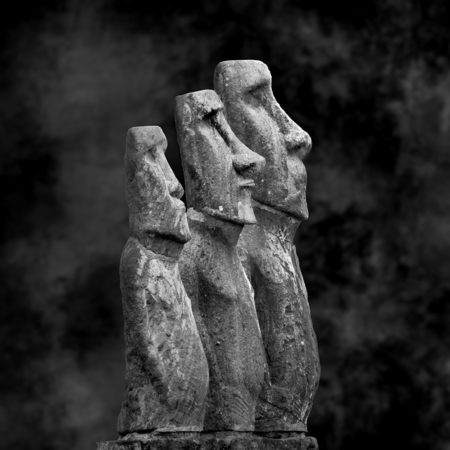
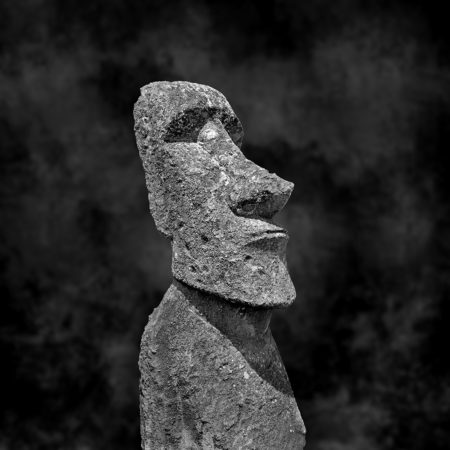
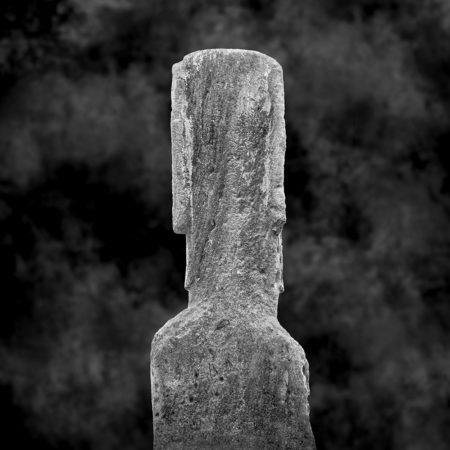
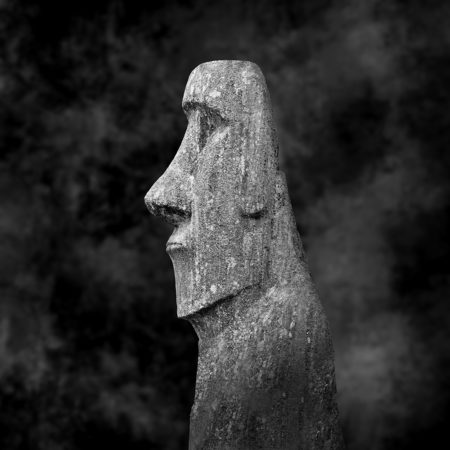

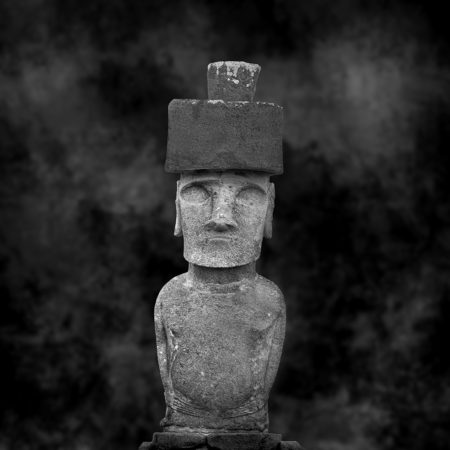

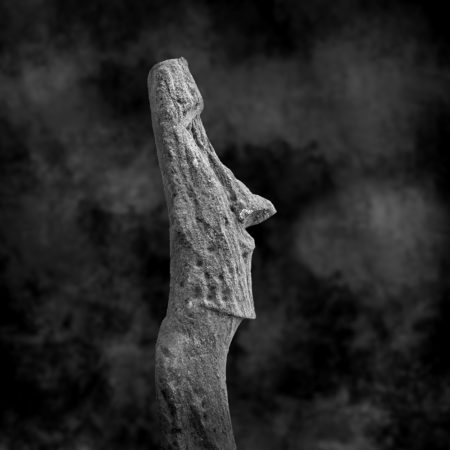
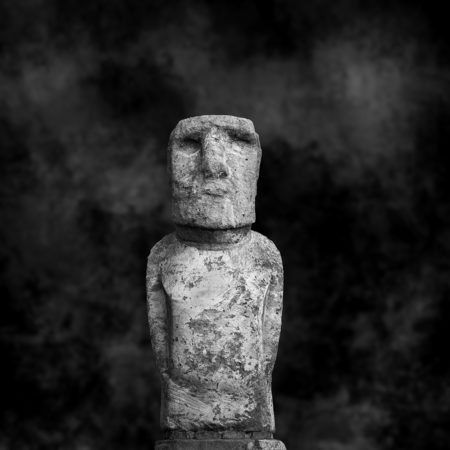
January 29, 2015
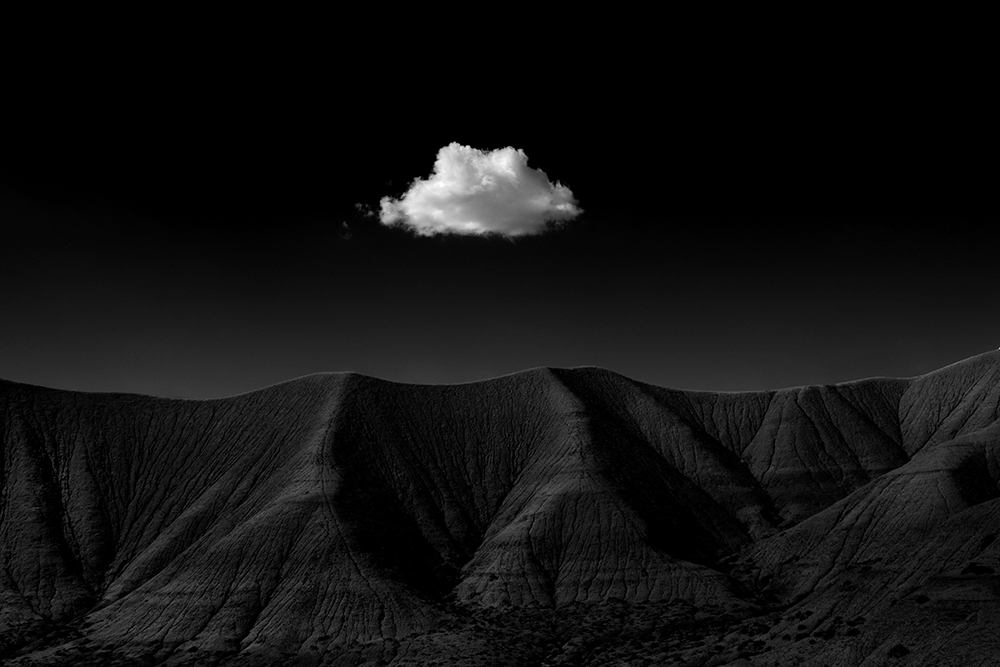
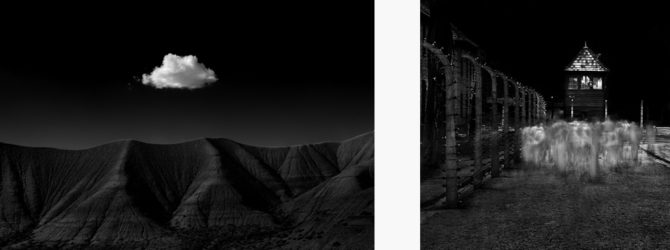
Harbinger Vs. Auschwitz
Last week I pointed out that my Harbinger image had almost 40 times more Flickr “favorites” than my Auschwitz image and I asked:
What do you think it means?
I heard a lot of great ideas and appreciated some new ones that I hadn’t thought of. And now I’d like to tell you what I think it means…
It means that more people like the Harbinger image.
What it doesn’t mean is that Harbinger is a “better” image. Popular does not mean better.
Who decides which images are good, bad, better or great? I do, but only for myself…and you do, but only for yourself. What I need to decide is:
Am I going to pursue popular or great?
Creating an image that is popular can be a fleeting pleasure. But when you create an image that you love, that’s a deep satisfaction that stays with you.
Here’s an image that I’ve just finished of the Moai at Tongariki.
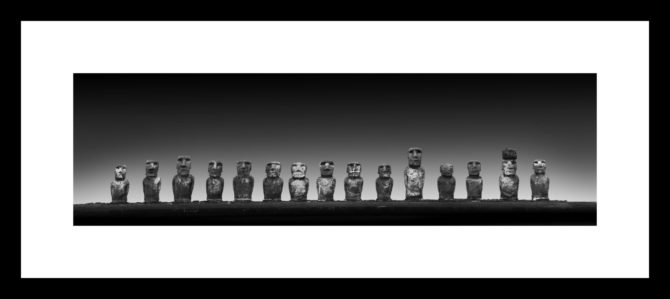
I love this image and so what other people think about it, is not important to me.
As I love to say: nobody is more of an expert than you when it comes to your Vision!
Cole
November 29, 2014
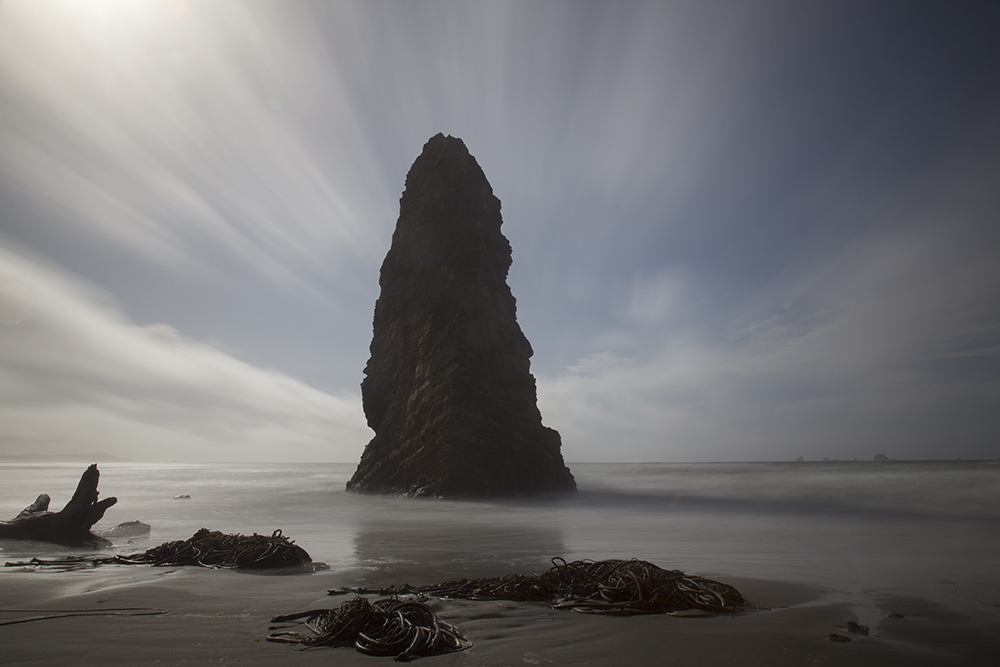
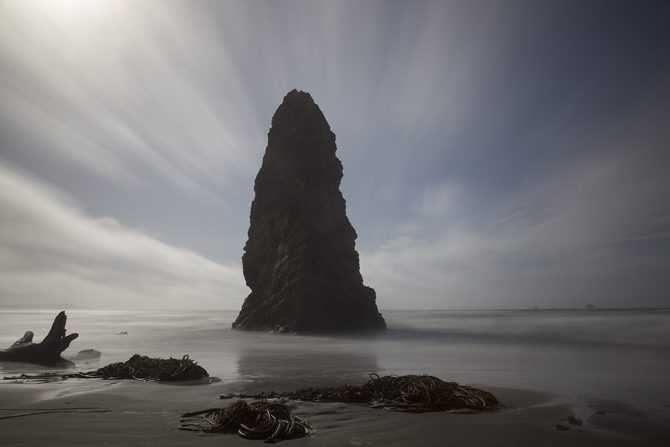
Monolith No. 78 – Before
I’ve had a number of people ask if I’d do some more “before and after” shots. So here are five from my recent Oregon trip.
~~~~~
I had my eye on this Monolith by Cape Blanco for several years, but I had never found an easy way to get down to the beach. On this trip I found one.
At the hour I get there (never early!) the monolith is backlit and so it’s a difficult shot. I was fortunate to have these great delicate clouds that streak well with a long exposure and I envisioned them becoming an important part of the image, if I could deal with the backlight.
The sun was in the upper left corner and it was washing out the clouds and giving me a big flare. I used my hand as a sunshade for the 30 second exposure, properly placing it by watching where my hand’s shadow fell on the lens. I knew that later in Photoshop I’d have to even out the sky, because it was bright on the left and darker on the right.
Then there was the debris on the beach from the last few days of big storms and high tides, but I knew that I could deal with that in post processing.
Monolith No. 78 – After
To deal with the debris I cloned out the tree stump and burned down the foreground to remove the rest. I don’t like anything that distracts from the main subject.
For the sky I burned down the upper left corner to bring out detail in the clouds, then I dodged up the right to balance the sky out. I also used a very small dodging brush to follow the cloud streaks to bring them out more. Adding contrast also helped the clouds stand out against the sky.
The backlighting didn’t hurt me as much as I feared it would. There’s not much shadow detail in the Monolith, but I generally don’t prefer a lot anyway.

Monolith No. 77 – Before
This is one of my favorite images from this trip. I envisioned this Monolith framed by the very dark hills on the sides, the rocks below and the clouds above.
This was a pretty simple image and an easy one…I thought…until I got home and found out that my Vari-ND was doing the dark pattern thing on me. It’s one of the quirks of all variable ND filters, sometimes at wide angles and when the sun angle is just right, you get these weird dark patterns across the image. And here’s a heads up: the cheaper the variable ND filter the more it will do this. That’s why I use the Singh-Ray Vari-ND, it happens much less frequently and when it does, there are a couple of workarounds.
If I had noticed the patterning in the field I could have switched lens and probably have avoided it. This was shot with my 24-105 at 24 mm, which is where the problem can happen, when you’re shooting at the wide end of your lens. If I had switched to the 16-35 and used 24 mm the pattern probably would have gone away, because 24 mm is mid focal length for that lens. And of course another option would have been to simply switch to a fixed ND filter for this shot.
This image also had some vignetting in the corners and I didn’t like how the clouds were thin on the right side of the image.
You might notice that I underexpose my images, usually by about 1 stop. I do this for a couple of reasons. First, I like the look of a dark image with pronounced highlights. Second, it makes it easier to deal with the wide dynamic range in these types of scenes where the sky is important to the image. If I had opened up another stop, that sky would have easily washed out and I’d have lost the cloud detail. Shadow detail is not very important to my images, so underexposing works for me.
Monolith No. 77 – After
I fixed the dark pattern in the sky with vey some careful and slow dodging (it’s easy for a sky to look blotchy if you use a small or hard brush or you work too quickly) I’m typically dodging and burning between 1-3% strength and for skies I’m generally using 1%. I used the clone tool to fix the vignetting and I also cloned in some clouds from the left to the right for a more balanced look.
I also used dodging and burning to bring out the water detail. I call it local contrast enhancement when I go back and forth between burning and dodging to increase the contrast in just one area.
I was happy with how this image turned out, especially after finding out about the dark pattern in the sky.
Something I noticed in the image above: there’s a thin highlight separating the sky from the monolith. I went back to the original TIFF and it’s not there, but it appears when I convert it to a JPEG for the web. I’ll have to do some work to figure out what that is and how to fix it.
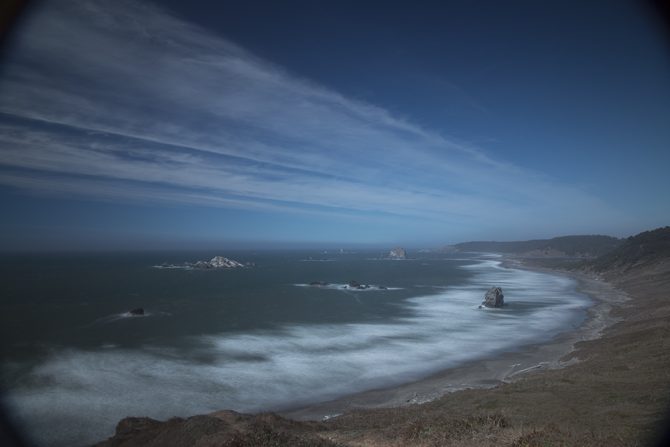
Cape Blanco – Before
People are naturally drawn to lighthouses, as are photographers. But the lighthouse shot is soooooo overdone that I almost didn’t create this one. But I thought I’d see if I could put my twist on it. I love to put the subject small in a large frame and then added a long exposure for a bit of movement. I underexposed and used a polarizer because I wanted black skies.
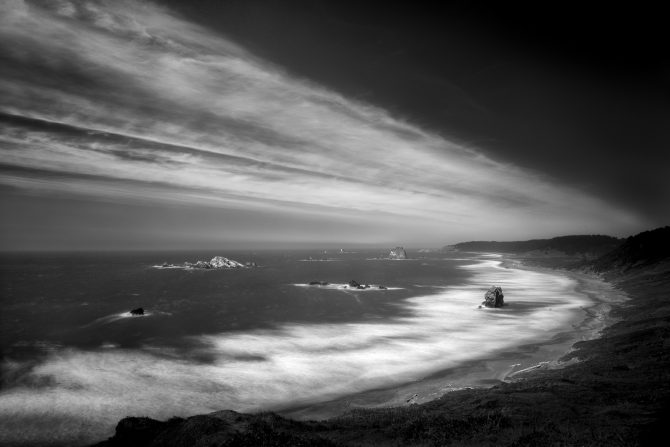
Cape Blanco – After
In the final image, I further isolated the lighthouse by burning down the foreground and the sky. Looking at this image now, a few weeks after I last worked on it, I think I’ll remove those trees on the far right because I find them distracting.

This illustrates how I work to refine an image. I’ll let it sit for a few weeks and then look at it with fresher eyes. I’ll then perhaps modify it again and then put it to bed for a few weeks more before I look at it again.
Now that I’ve removed those trees, I’ll come back in a week to see if I want to keep this change or not.
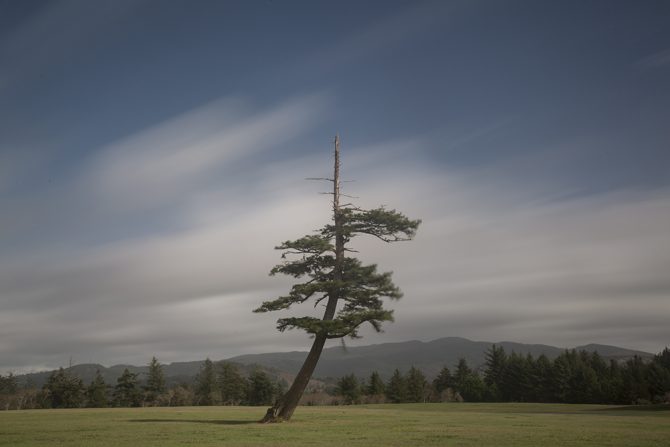
Isolated No. 7 – Before
I was driving on the road to Cape Blanco when this tree just jumped out at me! I love centered images and struggled if I should center the tree where it hits the ground or the upright of the tree. Centering the upright portion of the tree looked more centered and that’s what I went with.
It was a windy and hazy day which made the shot a little challenging. I took about 20 long exposures trying to get the clouds just right and ended up using this one. I didn’t underexpose as I usually do, because I didn’t want to lose the tree detail. It was still a processing challenge and I started over 4 times before I got it right.


Isolated No. 7 – After
Again, I did a lot of dodging and burning on this image. Many people feel that they can do this with a mouse, but I certain cannot! I use a pen and tablet and the control is so much better than with a mouse. I never like to be adamant, but you cannot do what I do with a mouse. Period.
I got rid of the shadow of the tree, that bothered me for some reason, and left a highlight around the tree. I darkened the sky and left it bright behind the tree. As I look at the image today, I think that I may go back and open up the trees a bit on the right side.
As I make decisions about my images, it reminds me of how I’ve seen some others make those decisions. They will show the image to someone and say: What do you think I should do to this image? I am very opposed to that approach, I think one should have a Vision and not adulterate it with someone else’s opinion.
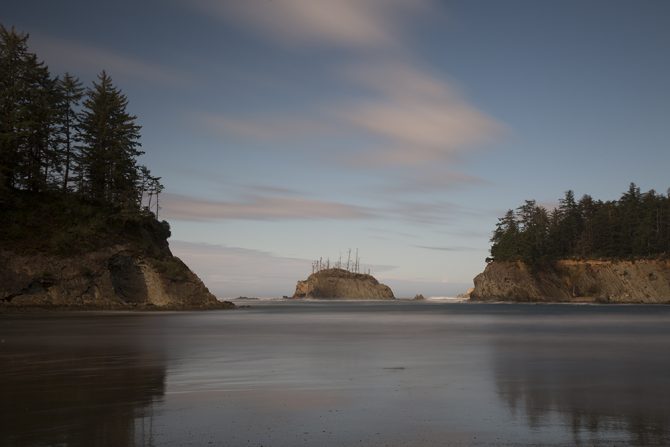
Isolated No. 6 – Before
I was lucky on this trip to have constantly changing weather conditions. Some days it was raining hard, others were sunny and others were constantly changing as on this day. The sun was coming and going and what I was trying to get was the sun hitting the island and the land left and right bits of land in shadow.
I was here for several hours trying to get the clouds and lighting just right. Sometimes the clouds were perfect, but not the foreground. At other times I’d get the shadowing how I wanted it but the clouds were no good.
I didn’t get exactly what I wanted in the shot, but I was confident that I’d be able to create the effect I was looking for in post processing.
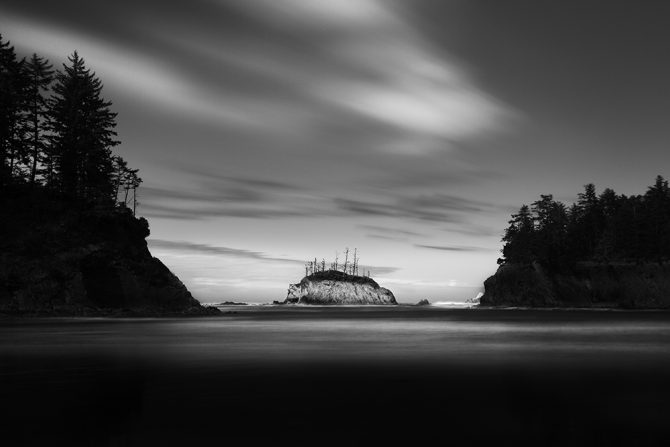
Isolated No. 6 – After
I burned the land down on the left and right to put the focus on the island. Then I dodged up the island to make it brighter. Then I went to work on the clouds, lightening the upper ones and darkening the smaller ones just above the island. Then I darkened the foreground to hide the detail and to bring the eye to the island.
~~~~~
So after seeing these “before and after” shots, I hope that you’ll not conclude that you need to learn more about Photoshop. It is not my intent to focus on post processing as the key to an image because that is exactly what I don’t believe.
Instead my approach is to have a Vision of the image and then let that drive the processing. When you have Vision, your processing then has purpose: to bring the image into compliance with your Vision.
And armed with that Vision, you don’t need to ask others what to do with your image, you already know how it’s going to look in your head!
Cole
November 21, 2014
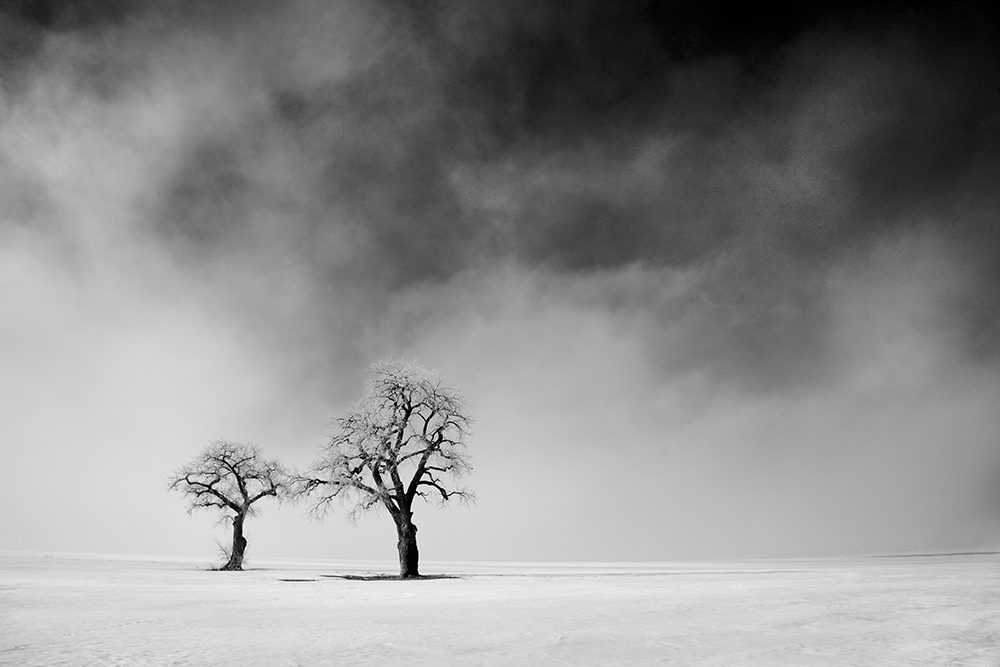
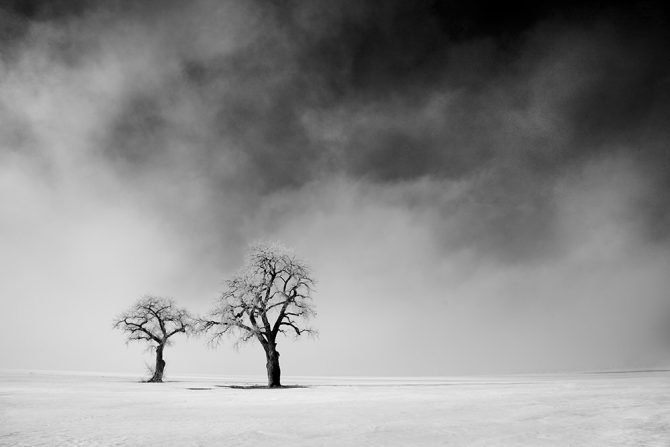
I’m often asked: what’s the best camera, lens or paper?
My answer is always the same: there is no “best.” Most cameras are excellent, almost all lenses are better than their masters and choosing a paper is simply about personal preference.
It’s easy to buy into the notion that the right equipment: camera, lens, accessories, plug-ins, printers or paper will transform our ordinary work into extraordinary images. However from my perspective great images are rarely great because they are technically perfect or printed on the right paper.
Or put more bluntly: I don’t think it really matters which equipment or paper you choose because they are not the critical component in a great image!
If you find yourself spending a lot of time researching the “best” (fill in the blank)…let me suggest another approach to improve your images.
Focus on the Image
Focus on your Vision
Focus on Composition
I believe a great image is created mostly from Vision and composition, and that technical skills plays a much smaller supporting role.

Where do you spend most of your time? Are you out of Balance?
But some will say: Can’t I seek both a great composition and technical perfection?
Yes, of course you can. But what I found in myself (and what I often see in others) was a tendency to spend the majority of my efforts on equipment, processes and technical issues, and very little time was spent working on my Vision or improving my composition.
I think the primary reason I did this was because I was insecure about my creative abilities, and I thought that I could compensate by excelling at the technical. And also let’s be honest, playing with equipment and learning new processes is just plain fun!
But Vision and composition is where the action is, and it’s how great images are created.
Cole
July 11, 2014
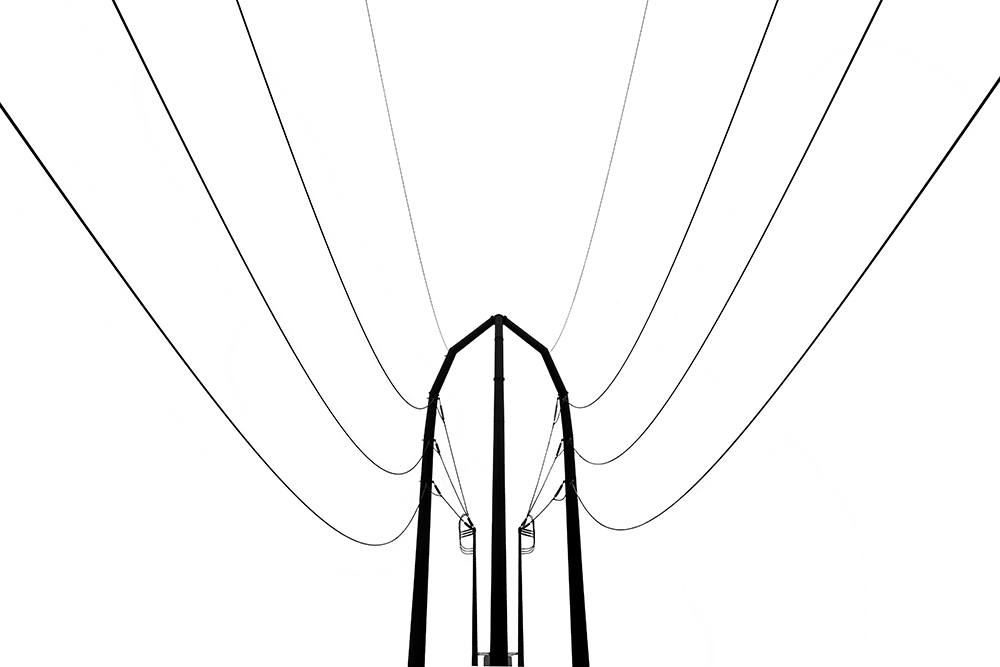
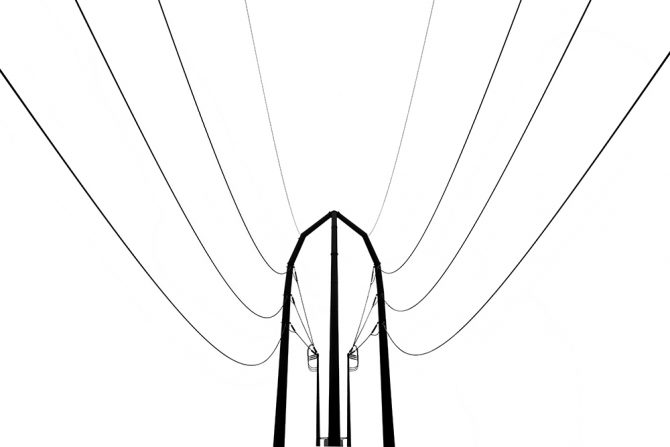
Minneapolis Power Lines
People often ask me if I would look at their work and critique it. And while I would love to accommodate, I am uncomfortable critiquing another person’s work and here’s why:
First, I’m unqualified. All I know is what I like and what I don’t like, and that should be irrelevant to you. Many think that because I create images they admire, this qualifies me to comment on their work, it does not. I am only qualified to judge my own images.
Second and most importantly, I believe that your opinion about your work should be the only one that matters. Your opinion is more important than mine or any other and it is the only one that can help you achieve true satisfaction from your work.
I used to ask others about my work, but in truth I was really looking for validation. I wanted the person to say “these are wonderful images, you are a wonderful photographer.” But even if they said those words, it didn’t make it so. Perhaps they were just being kind, and even if they were sincere, it was still just their opinion.
At the end of the day I need to respect and love my images and If I don’t, then it doesn’t matter how many people tell me that my images are wonderful.
How do you learn to trust your opinion over others? I think it starts with having a Vision of your work. Once you know how your images should look, then it becomes irrelevant what others think. Having a Vision of your work gives you great purpose and confidence.
When you don’t have that Vision, then the opinion of others is the only tool you have to gauge your work. And because you can never please everyone: true satisfaction can never come because you are subject to the changing whims and fancies of public opinion.
People frequently tell me what’s wrong with my images or what I should have done differently, but it doesn’t phase me. I know what I was trying to accomplish and only I know how close I came to fulfilling that Vision, they do not.
Tonight I was printing a copy of The Angel Gabriel and as I held the image in my hands I thought: this is beautiful, I love this image.
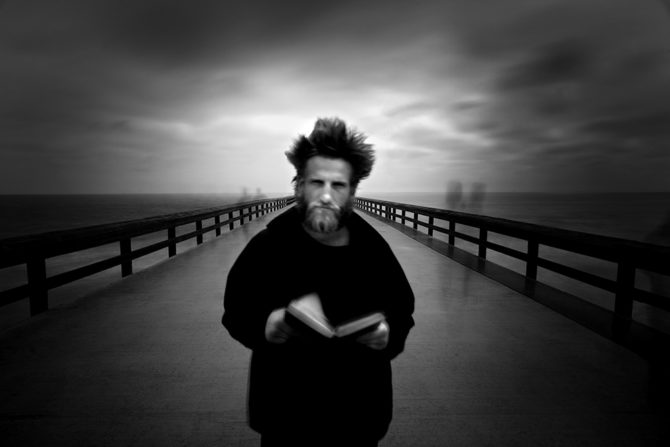
That satisfaction cannot come from another telling me how wonderful the image is, and it cannot be taken from me even if the image is unpopular.
My opinion is the only one that matters to me, and yours should be the only one that matters to you And that is why I don’t critique other’s images.
Cole

